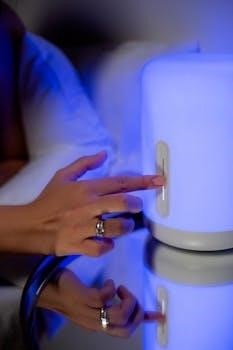Understanding Leviton Switches
Leviton switches are integral components in electrical systems, facilitating the control of lighting and other devices. They come in various types, each designed for specific functions and wiring configurations. Understanding their basic functionality is crucial for proper installation and operation, encompassing both standard and smart switches.
Basic Functionality of Leviton Switches
Leviton switches primarily function to control the flow of electrical current to a connected load, such as a light fixture. When a switch is in the ‘on’ position, it completes the electrical circuit, allowing current to flow and power the device. Conversely, when the switch is in the ‘off’ position, it interrupts the circuit, stopping the flow of electricity and turning off the device. These switches use a mechanical mechanism to open or close the circuit. The basic design involves contacts that physically connect or disconnect to allow or prevent current flow. Leviton provides various types of switches, including single-pole, three-way, and four-way, each differing in their internal circuitry and application. For instance, a single-pole switch controls a light from one location, while three-way switches enable control from two locations. Understanding these basic principles is vital for implementing and troubleshooting electrical systems involving Leviton switches. The switches are made to be safe and reliable if you follow instructions.

Leviton Switch Types
Leviton offers various switch types, including single pole, three-way, and four-way switches. Each type serves specific functions in different wiring configurations, affecting how lights are controlled. Understanding these differences is key.
Single Pole Switches
Single pole switches are the most basic type of light switch, functioning as a simple on/off control for a single light fixture or electrical outlet from one location. They have two terminals, and the circuit is either opened (off) or closed (on) when the switch is toggled. These switches are ideal for rooms where only one switch is needed to control the lighting, such as small bedrooms, closets, or bathrooms with a single entrance. The wiring is straightforward, with the hot wire entering one terminal and the wire leading to the light fixture exiting the other. This simplicity makes them easy to install and understand, suitable for basic home electrical setups. They are not suitable for controlling lights from multiple locations; for such applications, three-way or four-way switches are necessary. Leviton offers single pole switches in various styles and colors to match any décor.
Three-Way Switches
Three-way switches enable controlling a single light fixture from two different locations. Unlike single-pole switches, three-way switches have three terminals, plus a ground screw. These terminals include a common terminal and two traveler terminals. The wiring configuration is more complex than a single pole switch, requiring two three-way switches to operate correctly. The power source enters one of the three-way switches, travels through the traveler wires to the second switch, and then to the light fixture. The traveler wires allow the current to be redirected based on the position of both switches. This is especially useful in hallways, staircases, or large rooms where multiple entrances exist. Leviton offers a variety of three-way switches to meet diverse needs. Understanding the wiring diagram is essential for proper installation.
Four-Way Switches
Four-way switches, unlike single-pole or three-way switches, are used in conjunction with two three-way switches to control a light fixture from three or more locations. They have four terminals, excluding the ground screw, and are always placed between two three-way switches in a circuit. The current flows through the traveler wires, which are redirected by the four-way switch, allowing control of the light from multiple points. A four-way switch does not directly connect to the power source or the light fixture. Instead, it acts as an intermediary, toggling the flow of electricity between the two three-way switches. A proper understanding of the wiring diagram is crucial to avoid damaging the electrical circuit. Leviton offers reliable four-way switches that are compatible with standard wiring practices.

Wiring Diagrams
Wiring diagrams are essential for installing Leviton switches correctly. They provide a visual guide on how to connect the wires to the switch terminals, ensuring proper function and safety of the electrical circuit.
3-Way Switch Wiring Diagram
A 3-way switch wiring diagram is crucial for understanding how to control a light fixture from two different locations using two 3-way switches. This diagram illustrates the connections between the power source, the two switches, and the light fixture. It typically involves a common terminal, two traveler terminals on each switch, and the neutral wire. The power feed enters one switch’s common terminal, then traveler wires connect both switches’ traveler terminals. The light fixture is wired to the common terminal of the second switch. This configuration allows the light to be turned on or off from either location. Correctly following the 3-way switch wiring diagram is essential for safety and functionality, preventing short circuits and ensuring proper operation of the lighting system. Always double-check the wiring before finalizing the installation.
4-Way Switch Wiring Diagram
A 4-way switch wiring diagram is necessary when controlling a light fixture from three or more locations. This setup uses two 3-way switches at the beginning and end of the circuit, and one or more 4-way switches in between. The 4-way switch diagram shows how the two traveler wires from one 3-way switch are connected to the input terminals of the 4-way switch, and then the output terminals go to the next 4-way switch, or to the final 3-way switch. This arrangement ensures that toggling any switch will change the state of the light. Understanding this wiring is crucial for correct installation and avoiding short circuits. Always verify the wiring diagram before connecting your switches to ensure proper functionality and safety. The 4-way switch acts as an intermediary, allowing multiple points of control.

Smart Switch Wiring
Smart switch wiring involves connecting a Leviton smart switch, often in a 3-way configuration, to enable remote control. This requires understanding specific diagrams for proper integration with your home’s electrical system.
Leviton Smart Switch Wiring Diagram
The Leviton smart switch wiring diagram is crucial for successfully integrating these devices into your home’s electrical network. These diagrams typically illustrate how to connect the smart switch in both single-pole and multi-way configurations. Specifically, the 3-way setup, which allows control from two different locations, requires careful attention to ensure the traveler wires are correctly identified and connected. The diagram will clearly show the line (hot) wire, the load wire going to the light fixture, the neutral wire, and the ground wire. It also illustrates how to connect the traveler wires between the smart switch and the companion switch. Furthermore, diagrams often provide color codes to make wiring easier, for instance, black for hot, white for neutral, and green for ground. These diagrams are essential for proper function and for preventing electrical hazards. Always consult the specific diagram for your Leviton smart switch model, as they may vary slightly. Using the diagram correctly ensures the switch operates as intended.

Installation Tips
When installing Leviton switches, always prioritize safety. Turn off the power at the circuit breaker before starting any work. Double-check all connections are secure and correct, and never overload circuits.
Safety Precautions
Before initiating any electrical work involving Leviton switches, it is paramount to prioritize safety by taking essential precautions. Always begin by disconnecting the power supply at the circuit breaker panel to the specific circuit you will be working on. This step is critical to avoid the risk of electrical shock. Confirm that the power is indeed off using a non-contact voltage tester before touching any wires or terminals. Never assume that the power is off, even if the light or device controlled by the switch appears to be off. Ensure that you understand the basic principles of electrical wiring and are comfortable working with electrical circuits. If you are unsure about any aspect of the installation process, it is highly recommended to consult a qualified electrician. Avoid working in wet or damp conditions, as this increases the risk of electrical shock. Use insulated tools designed for electrical work to further minimize the risk of shock. Always adhere to local electrical codes and regulations, and double-check your connections before restoring power to the circuit. Proper adherence to these precautions is crucial for a safe installation.
